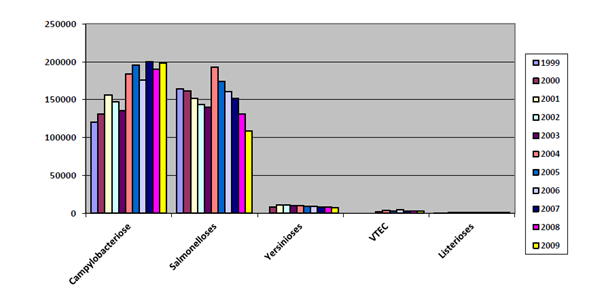Microbiological risks in food
The work of ANSES
Controlled hazards and emerging risks
Many microorganisms (bacteria, viruses, parasites) are able to contaminate foodstuffs and cause a variety of illnesses. Measures implemented by health authorities and practitioners have resulted in a significant reduction in the main diseases linked to food (Salmonella, Listeria, etc.) and microbial hazards are generally well controlled in food. Therefore, the number of foodborne illness outbreaks (FBI) related to Salmonella decreased by nearly 50% between 2004 (the implementation date of Regulation 2160/2003/EC) and 2009 in Europe. However, vigilance must be maintained with regard to microbial hazards.
Thus, the serious matter of Campylobacteriosis (the primary cause of foodborne illnesses in Europe linked to the consumption of food products contaminated by Campylobacter), the sudden emergence in Germany and France in 2011 of an outbreak related to the contamination of fresh produce by the bacterium E. coli O104:H4 that affected more than 3500 people, or the recent episodes of contamination of fresh produce that occurred in the UK and the United States, call for greater vigilance regarding microbiological risk, especially emerging risk, and greater attention to be paid to fresh produce that has been less implicated in collective food poisoning outbreaks, up to now.

The missions of the Agency
In general, the Agency’s mission in the area of biological risks is:
- to assess the list of hazards established by professionals in their guides to good hygiene practice;
- to produce scientific papers useful to the identification of microbiological hazards (data sheets on foodborne biological hazards, Opinions or reports on certain pathogenic microorganisms);
- to carry out assessments and research on the effectiveness of specific control measures proposed or implemented by professionals;
- to provide scientific and technical support to the authorities, in connection with monitoring and control: definition of monitoring and control plans (sampling and testing procedures and methods, etc.).
In the area of research and diagnosis
ANSES relies on its network of laboratories to monitor major and emerging foodborne pathogens and help to improve diagnostic methods.
It develops modelling tools (for example,modelling the risks associated with Campylobacterfound in the poultry sector, managing risk linked to the presence of entero-haemorrhagic Escherichia coli (EHEC) in the meat, raw milk and raw milk cheese sectors) to better assess the impact of applying risk control standards and measures.
Information for professionnels
The Agency has produced fact sheets on the main foodborne biological hazards (bacteria, viruses, parasites, moulds and toxins). Each sheet details the characteristics of the hazard, the human foodborne illness, the role of food as well as the main elements related to domestic hygiene. These sheets are designed to help food industry professionalsprepare guides to good hygiene practice. They are regularly updated, making them reliable scientific tools.


